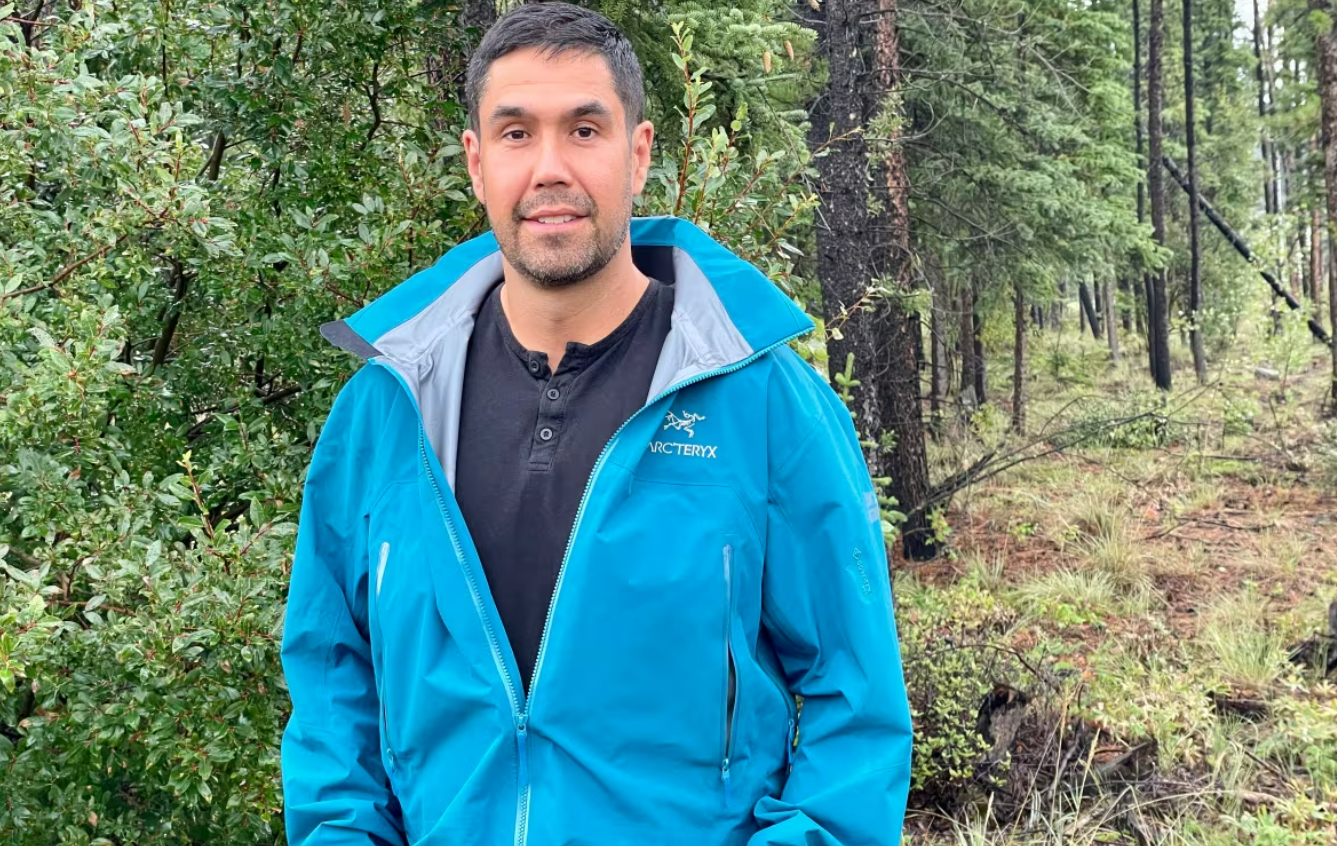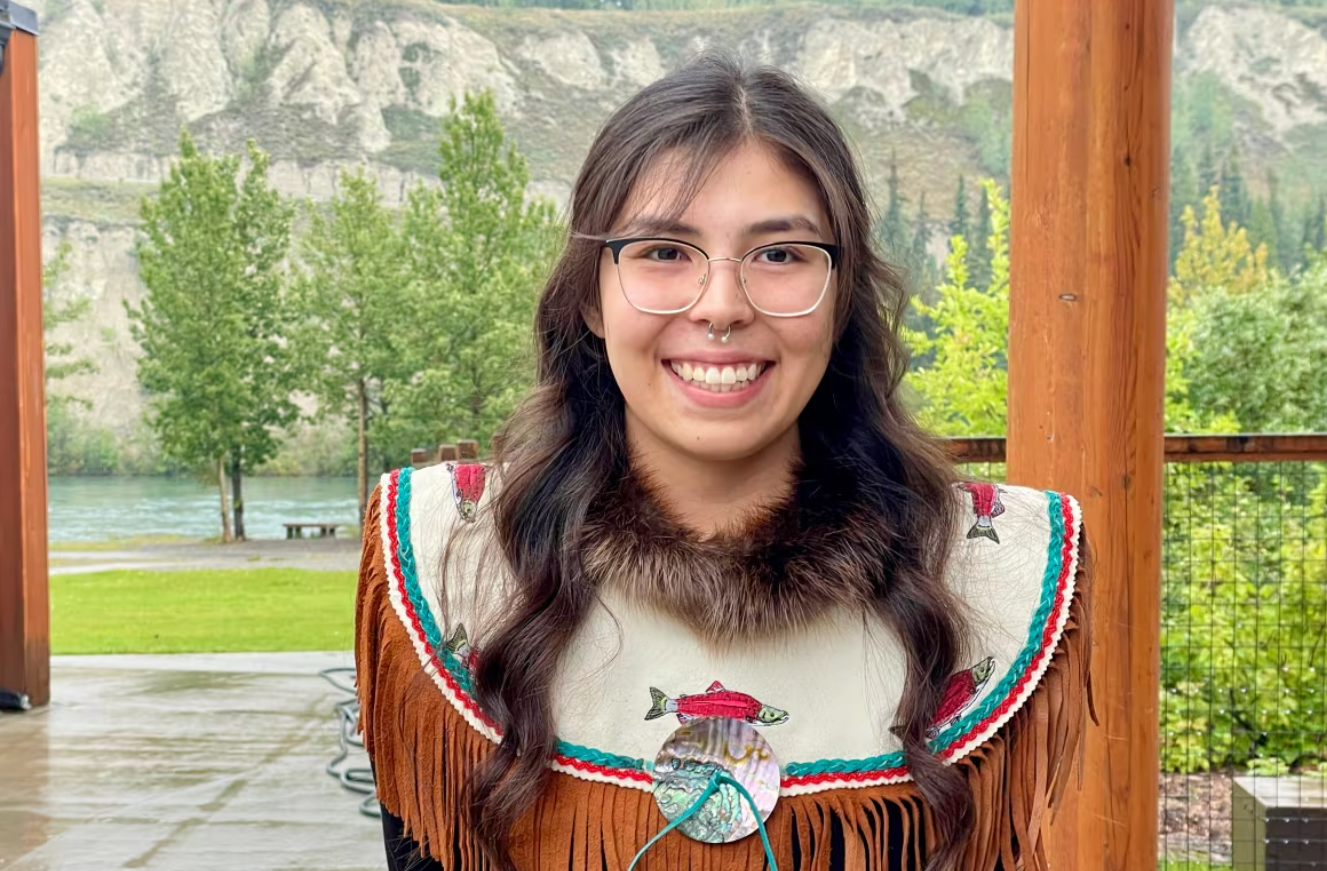Canada News
Warmer temperatures have put chinook salmon — and a way of life — in grave danger

Steven Shorty demonstrates hanging fish in the smokehouse at a Salmon Week event in Whitehorse on Aug. 22, an event organized by the Kwanlin Dün First Nation. Because there’s a seven-year moratorium on fishing Chinook, these are sockeye salmon brought in from the Taku River in northern B.C. (Rachel Sanders/CBC)
By Brandie Weikle, RCI, CBC News
At the home James MacDonald shares with his wife and their two kids, it’s approaching dinnertime. His five-year-old son, Sye, is helping MacDonald open a can of salmon.
As a citizen of the Ta’an Kwäch’än Council — one of several First Nations known as “salmon people” — MacDonald’s ancestors have been fishing chinook salmon for millennia.
But that way of life couldn’t feel further away than it does right now.
“My wife and I were down at Costco a couple of weeks ago in Vancouver … and we bought $300 worth of canned sockeye. And, you know, it’s the only way at this point that we can have salmon in our house,” said MacDonald, a member of the federally appointed Yukon salmon sub-committee.
In an effort to preserve dwindling chinook stocks, MacDonald says he hasn’t fished on the Yukon River since he was a young boy.
“Culture doesn’t come from a can, but when we prepare it with the kids we can still talk to them and tell them about what salmon means to us.”
CBC Radio’s What on Earth travelled to Yukon this summer to explore how a warming climate has threatened chinook salmon, endangering not just the species but a cultural keystone for these Indigenous communities. There, it found that an unprecedented seven-year moratorium on fishing mandated by Canada’s federal and Alaska’s state governments, combined with other conservation efforts, may be netting some success.

This summer about 24,000 chinook were counted moving up the Yukon River at the border with Alaska. That’s compared to historic lows of 12,000 and 15,000 the last two seasons, says Elizabeth MacDonald, a biologist and fisheries manager for the Council of Yukon First Nations.
The fishing moratorium has only been in place for five months.
“I don’t want to sound too joyous, because if we were talking about the run like we’re having right now, five years ago, we would have been devastated by the numbers,” said MacDonald, who lives in Whitehorse. “But it is better than the last few years. I’m really grateful for that.”
When data on the salmon run was first collected in the 1980s, between 100,000 and 200,000 chinook would enter the Yukon River, MacDonald said. Anywhere from a quarter to more than a third were destined to make that crossing into Canada.
Why chinook are struggling
Canada’s North is warming faster than the rest of the country. Temperatures there have risen an average of two to four degrees since 1950, compared to an average of 1.9 C from 1948 to 2021 in Canada as a whole, according to Environment and Climate Change Canada.
Those hotter temperatures have a number of negative impacts on the chinook, MacDonald said.
The migration they make to return to their spawning grounds is the longest salmon run in the world, stretching to around 3,000 kilometres. The journey takes two months, during which time the chinook eat nothing — all while performing what MacDonald calls the fish equivalent of running a marathon uphill.
Definitely, we need cold oceans if we want to have salmon.
– Elizabeth MacDonald, fisheries manager
The conditions in the ocean in the months and years before the fish start the trip are critical to how they fare.
“Out in the ocean, when things warm up, salmon don’t survive as well and you see less of them. And they also tend to be smaller when they do come back,” she said.
That’s because the warmer waters make their metabolism run faster, leaving lower energy stores for the trip, she said.
“So, definitely, we need cold oceans if we want to have salmon.”
If once the chinook are in the river, hot and dry conditions have created lower water levels, the water there will also be warmer, she said.
“So to go the same distance, you now need more energy or more food, which means you eat through your reserves quicker, which is part of the reason why maybe some of the fish are dying before they make it to spawn.”
Warmer rivers also mean lower oxygen levels in the water, making it harder for the fish to meet the demands of their swim, she said.
On top of that, a common and often fatal ocean parasite that infects chinook has grown more prevalent in warmer conditions.
“The last several years, the infection level has come up quite considerably, and that is likely one of the biggest contributing factors to the salmon that are dying in the river,” MacDonald said.
The parasite known as Ichthyophonus hoferi is one of the major threats devastating chinook salmon populations in Yukon, and it’s impacting the lives of those who rely on them. Elizabeth Macdonald explains the parasite’s effect on the salmon population.
It’s not just the climate affecting chinook stocks.
In the past, some Yukon First Nations have blamed overfishing in Alaska for reducing the number that reach spawning grounds. Mining disasters have spilled contaminants into salmon-bearing streams and the logging industry’s practice of floating log booms along the river has been shown to be detrimental to the fish.
Though not the driving force behind the decline, some First Nations people have played a part in overfishing the chinook by also working as commercial fishers, James MacDonald said.
Colleen James, a community co-ordinator and cultural advisor for How We Walk With the Land and Water, says that some in the Canadian government are starting to listen to First Nations communities when it comes to making decisions on land and water use.
The loss of fish camps
For the First Nations peoples who traditionally rely on the chinook for sustenance, the devastating decline in fish stocks has cut them off from a beloved practice of gathering at riverside fish camps in late summer.
There, they would catch salmon in nets, then fillet and dry them to store over winter.
“Those were happy times, happy memories,” said MacDonald, recalling his childhood fish camp experiences and the excitement of checking the nets early each morning. “As a boy, I can tell you it was an endless amount of fun … It’s a deep well of sorrow to not be able to share that joy with my family.”
More recently, some communities have begun to hold fish camps by flying in frozen salmon. That way, young people can learn from elders how to fillet and hang the fish — and to connect to their cultural heritage.

Bêlit Peters, 22, has never experienced salmon camps like her elders. But a few years ago she had a summer job on the Ta’an Kwäch’än Council’s salmon restoration project at Fox Creek. Then something magical happened, she said.
Her group came to a pool of water that opened up to the lake, “and there was this huge salmon … the size of my arm. And I was like, what is that? And I remember my boss, Deb Fulmer, she was like, ‘That’s a salmon.’ And we were all so happy because we hadn’t seen one … And I spotted it. It was so bright red in the water.”
Peters is now a youth community co-ordinator with a project called How We Walk with the Land and Water, which aims to create a unified First Nation vision for how regional land and water planning is handled in the Southern Lakes district, which covers the 24,753 square kilometres surrounding Whitehorse, with the B.C. border as its lower boundary.
She said she used to feel like protecting salmon was something she had to do.
“Now I feel like it’s more of like a ‘I want to,’ like it’s my duty, kind of like it’s always been my job to do that,” she said.
“I’m hopeful that the salmon are going to come back …. I’m wishing on it.”
In an email, the Yukon government said it recognizes “the tremendous impact Yukon River salmon decline has had on Yukon First Nation subsistence harvest, culture, food security and traditional practices.
“For years, Yukon First Nations have voluntarily reduced or ceased subsistence salmon fishing to help restore the species and work towards building a territory where salmon can be harvested by future generations.”
While it doesn’t have a formal role in salmon management, the territorial government is “committed to working with partners to conserve and protect wild Pacific salmon for future generations,” the statement said.
An email to CBC from Canada’s Department of Fisheries and Ocean said, in part, that it’s working with Yukon First Nations, the territorial government and Yukon First Nation Salmon Stewardship Alliance to develop a plan to rebuild the Yukon River chinook salmon stock.
It also said the department is working with the U.S. “to highlight concerns regarding continued declines of Pacific salmon and factors contributing to those declines.”





















